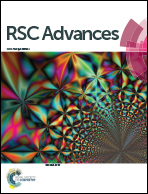Preparation and photoelectrochemical properties of BiFeO3/BiOI composites
Abstract
BiFeO3 thin films were spin coated onto FTO. BiFeO3/BiOI composites have been successfully synthesized by an electrochemical deposition method. The morphology, structure and optical absorption properties of the as-synthesized samples were characterized via XRD, SEM, and UV-Vis DRS. The effect of the BiOI electrodeposition cycles on the photoelectrochemical properties of the BiFeO3/BiOI composites were investigated. The results showed that the photoelectrochemical properties were enhanced under simulated solar light. The composite could achieve an optimum photocurrent density of 16.03 μA cm−2 at 0 V (vs. Ag/AgCl), which is more than twice that of pure BiFeO3 thin films (6.3 μA cm−2). In addition, the Mott–Schottky curves indicate an improvement in the carrier density of the composite. The enhanced photoelectrochemical properties of the composites can be attributed to the formation of a heterojunction at the interface and the band bending of the ferroelectric material BiFeO3.



 Please wait while we load your content...
Please wait while we load your content...